Mystery
Mesa: A Masonic Temple Beside An Ancient Hopi Village
Originally
published as "Ancient Egyptians in Arizona?", the lead article in Ancient
American magazine, Vol. 8 Number 49.
(Please
be patient while graphics are loading.)
by
Gary A. David
Copyright
© 2002 by Gary A. David.
“The
primitive men met in no Temples made with human hands. ‘God,’ said Stephen,
the first Martyr, ‘dwelleth not in Temples made with hands.’ In the open air,
under the overarching mysterious sky, in the great World-Temple, they uttered
their vows and thanksgivings, and adored the God of Light; of that Light that
was to them the type of Good, as darkness was the type of Evil.”
Albert
Pike, 33rd degree Mason 1.
On top of the western edge of a low mesa near Winslow, Arizona stands a huge
white cross. I hop over a barb wire fence and begin walking over an abandoned
cattle pasture, using the cross as a point of reference. In the distance to
the west a wind mill rises above a lone ranch house, a small clapboard structure
that seems to belong to an earlier era.
 |
Scrambling
up the mesa without too much difficulty, I see that my destination is actually
a Christian cross made of steel painted white but now starting to rust. Measuring
approximately 30 feet high and 10 inches in diameter, it is positioned toward
the west end of an amphitheater at the top of seven steps leading up to it from
the lower level. This oval-shaped amphitheater constructed of concrete is about
120 feet long, 60 feet wide, and a couple feet high, providing ample seating
along its perimeter.
 |
 |
 |
Not
more than 25 yards southwest of the cross, I come upon Cottonwood Creek Ruin,
which the Hopi call Söhöptsokvi. The Hopi, whose ancestors once lived in these
villages now lying in ruins, have settled upon primarily three large mesas about
50 miles north of this site. The 50 room pueblo village here was inhabited between
about 1275 and 1375 AD. This masonry structure was relatively small in comparison
to the Anasazi pueblo of one-thousand or more rooms (known as Homol'ovi II)
located 9 miles to the northwest within the boundaries of Homolovi
Ruins State Park. 2.
However, the brown sandstone cliffs below the mesa top abound in ancient petroglyphs.
Rock art expert Sally Cole has found at least 12 examples of kachina iconography,
which she meticulously records in a typically dry, academic style. 3.
I found something more.
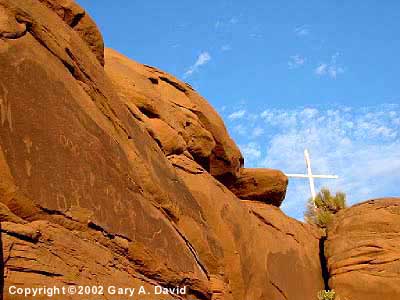 |
I recalled that Karen Berggren, the park manager at Homolovi, had mentioned
simply that this was once a Masonic worship site. Park Ranger Kenn Evans, II,
himself a Mason, later added that the site was constructed in the late 1920’s
or early 1930’s by Winslow Masonic Lodge # 13 and its corresponding female organization,
the Order of Eastern Star, Ruby Chapter # 6. 4.
It is rather ironic that the outdoor gathering place for this secret society
should be juxtaposed to a masonry pueblo. In fact, I’ve seen nothing like this
in the entire Southwest. Sometimes mission churches were built next to ancient
villages, like those in Pecos National Historical
Park and Gran Quivira in Salinas Pueblo
Missions National Monument, both in New Mexico, but otherwise this is an
anomaly.
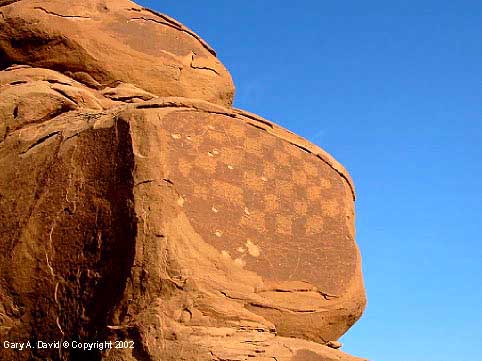 |
The
petroglyphic evidence upon the vertical cliffs below the pueblo ruin struck
me as strange, even in the context of the Anasazi. One encounters a well executed
checkerboard formed in an oval shape facing northwest-- or more exactly, 300
degrees azimuth, the summer solstice sunset. The checkerboard pattern in Anasazi
rock art is thought to symbolize the Milky Way, the pathway for the Warrior
Twins. 5. However, in the context
of Freemasonry the black and white checkerboard found on the floor of each lodge
represents night and day, or death and everlasting life. 6.
A checkerboard was also one of the ancient Egyptian hieroglyphs used to indicate
a scribe’s palette, therefore connoting the wisdom of Thoth. 7.
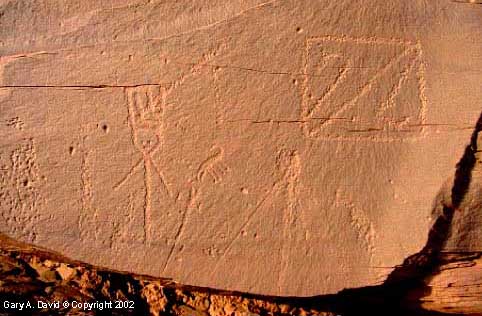 |
On
one boulder I found an incised stick figure with a four-pronged headdress standing
next to a lizard and perhaps a dog. To the right and slightly above was a square
divided diagonally with a crook carved into each section, each one facing opposite
directions. The square represents “place” or “house,” so this glyph may be expressing
the House of the Two Crooks. In Anasazi ideograms the crook or reed cane can
symbolize fertility or the production of rain, and is frequently held by the
ichthyphallic Kokopelli.
The crook is also associated with the emergence legend, because the people had
ascended through a reed from the previous Third World to the current Fourth
World. In addition, it may symbolize either the ceremonial curved warriors’
staff or the atlatl, the latter of which was the primary weapon used prior to
the advent of the bow and arrow circa 500 AD. 8.
Although the Hopi word for shepherd’s crook is ngölö, the semantically
related word for “hooked” is hewakna. In Egypt heq-t referred
to “shepherds crook,” which represented divine sovereignty, rulership, and royal
dominion or power. 9.
This crook painted or inlaid with alternating dark and light horizontal
bands was held by Osiris and other gods. I might add that the striped pattern
also mirrors the pharaoh’s nemes, or royal headdress, similar to the
one fashioned on Tutankhamun’s
gold death mask. It is interesting to note that from the Hopi First Mesa
village of Hano (Tewa) comes the Koshari, a figure with broad black and white
bands painted horizontally on his body and a curved hoe somewhat resembling
a crook in his left hand. Simultaneously sacred and profane (like the aforementioned
checkerboard dichotomy of eternal light and ephemeral darkness), this ritual
clown participates with rowdy humor in the kachina dances. 10.
Known in his kachina capacity as a Koyaala,
he is a singer to the Big-Horned Sheep kachinas, whose petroglyphic representation
indicating rainfall I also found at the site. 11.
 |
 |
One
petroglyph panel located within sight of the cross atop the mesa is particularly
interesting. A figure with very large eyes and a crook or whip in its right
hand holds hands with a smaller figure on the right, while a third figure farther
to the right holds some kind of staff. To the left of this grouping is a sinewy
snake juxtaposed with a clear alchemical symbol of the planet Venus (a circle
surmounting a cross). In Maya symbology the feathered snake Kukulkan is associated
with Venus as the Morning Star. The Aztecs called it Quetzalcoatl.
On another panel nearby, an additional Maya icon, the quetzal bird that originates
in the jungles over 1500 miles to the southeast, has been carved next to a spiral.
Feathers and even whole birds were once part of an extensive trade network between
Mesoamerica and the Four Corners region. Because of the light and shadow that
fall across this stone, the petroglyph may be a solstice marker.
 |
Near the top of the aforementioned panel are three circles arranged horizontally
and connected with straight lines. These possibly represent three moons. Also
depicted are a horned zoomorph, a human footprint, and a stylized bird. Near
the top right of the panel some sort of ritual artifact resembling a modern
open-ended wrench has also been carved.
 |
 |
On
yet another panel to the left of this grouping of glyphs are two more eerie
figures. One has a rectangular body with geometric designs inside of it, clawed
hands and feet, insect-like eyes and antennae. The figure to its right also
has large eyes and a line coming out of the top of its head that ends in a circle.
These two figures, both with upraised arms, are assuming what is known in Anasazi
iconography as the prayer stance. In Freemasonry this posture with hands raised
and elbows at right angles is referred to as the “Grand Hailing Sign of Distress.”
12. To the right of this pair are
three “crows feet,” representing the warfare motif consistent with the Warrior
Twins previously mentioned. (For crows feet icon, see the right side of my black
and white photograph of the same petroglyph at the end of this essay.)
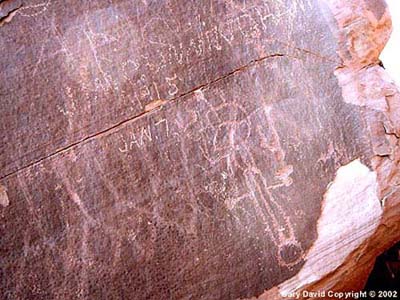 |
Finally, I found an enigmatic petroglyph that may be a cross, a plumb line,
the hilt of a Masonic sword, or even a stylized anthropoid. You decide. This
rock art appears to involve three different periods. The most recent (and most
crude) gives a scratched-in date of Jan. 7, 1915, roughly the time that the
Masonic temple was constructed. The much older figure seems to be holding in
its left hand (?) some sort of artifact. The head (or pommel) has a equilateral
cross or star within it. Extended from the “neck” toward the figure’s right
side is a circle with what looks like horns on top. This figure is superimposed
on a horizontal series of linked diamond shapes, which appear to be the oldest.
These are thought to represent rattlesnakes, stars, or female puberty rites
of passage. 13. Again, you decide.
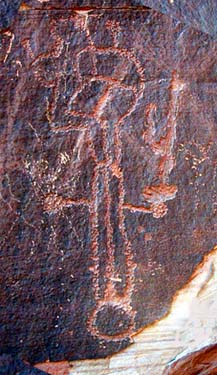 |
 |
|
Close-up
of petroglyph above
|
Masonic
sword (See Old
World History web site.)
|
So what is going on here? We have a Freemasonry temple built in the early 20th
century next to a pueblo constructed in the late 13th century. In the adjacent
rock art we find Mayan and Egyptian symbology mixed with traditional Anasazi
petroglyph designs. Why did the Masons chose this particular mesa to erect their
open-air worship center? Did the crumbling foundations of the village remind
them of their sacred office? Did they recognize the non-indigenous iconography
of this rock art, which resonated with specific elements in their holy ceremonies?
Was an elite cabal operating within the rural Arizona Masonic lodge privy to
arcane lore which dictated that the site be established precisely where we find
its ruins today?
Remember that the Hopi name for this site means “cottonwood,” whose root is
used for the carving of kachina dolls. If one cuts crosswise into the limb of
this tree, a perfect five-pointed star of Egyptian design is revealed. The Hopi
word for cottonwood is söhövi. The Hopi word for star is sohu.
Although though the vowels are arbitrary, the Egyptian word for star (particularly
those of Orion) is sahu.
The deep mystery of this low mesa endures.
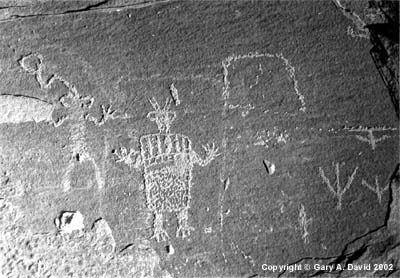 |
an excerpt
from The Orion Zone: Ancient Star Cities of the American Southwest
Copyright © 2002 by Gary A. David. All rights reserved
Any use of text or photographs without the author's prior consent is expressly
forbidden.
Contact: e-mail islandhills@cybertrails.com
End Notes
1. Albert Pike, Morals and Dogma of the Ancient and Accepted Scottish Rite
of Freemasonry Prepared for the Supreme Council of the Thirty-third Degree for
the Southern Jurisdiction of the United States and Published by Its Authority
(Charleston, South Carolina: A. .M. . 5632, 1928, 1906, 1871), p. 277.
2. Anasazi is the Diné (Navajo) word that archaeologists use to refer to the
ancestral pueblo people. It literally means “ancient enemies.” The Hopi more
correctly refer to their ancestors as Hisatsinom, or the “Old People.”
3. Sally J. Cole, Katsina Iconography in Homol’ovi Rock Art, Central Little
Colorado River Valley Arizona (Phoenix, Arizona: Arizona Archaeological
Society, March 1992), p. 110. A kachina is a masked, intercessory spirit that
takes the form of any object, phenomenon, or creature in the universe.
4. Personal email communication, 9/3/02.
5. James R. Cunkle and Markus A. Jacquemain, Stone Magic of the Ancients:
Petroglyphs, Shaman Shrine Sites, Ancient Rituals (Phoenix: Golden West
Publishers, Inc. 1996, 1995), p. 167.
6. Maurice Cotterell, The Tutankhamun Prophecies: The Sacred Secret of the
Maya, the Egyptians, and Freemasons (Rochester, Vermont: Bear & Company,
2001, 1999), p. 193.
7. Stéphane Rossini, Egyptian Hieroglyphs: How to Read and Write Them
(New York: Dover Publications, Inc., 1989), p. 46.
8. Cunkle, Stone Magic of the Ancients, pp. 67-68.
9. E. A. Wallis Budge, An Egyptian Hieroglyphic Dictionary, Vol. I (New
York: Dover Publications, Inc., 1978, 1920). pp. 512-513.
10. Barton Wright, Hopi Kachinas: The Complete Guide to Collecting Kachina
Dolls (Flagstaff: Northland Publishing, 1993, 1977, p. 78-79, p. 82.
11. Alph H. Secakuku, Following the Sun and Moon: Hopi Kachina Tradition
(Flagstaff: Northland Publishing/Heard Museum, 1998, 1995), p. 85.
12. Malcolm C. Duncan, Duncan’s Ritual of Freemasonry, Or Guide to the Three
Degrees of Mark Master, Past Master, Most Excellent Master, and the Royal Arch
(New York: David McKay Company, Inc., third edition, no copyright date), p.
18.
13. Cunkle, Stone Magic of the Ancients, pp. 168-169.
![]()